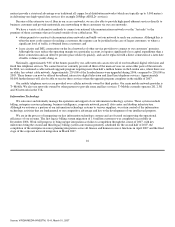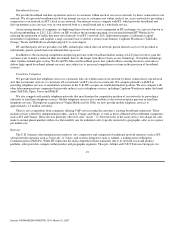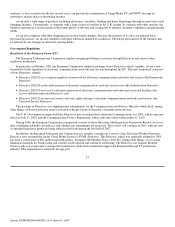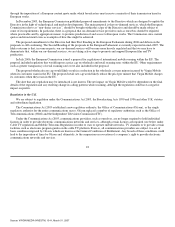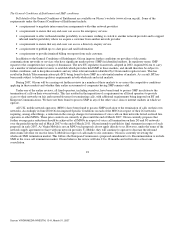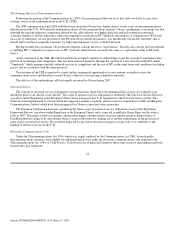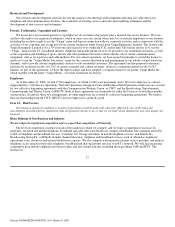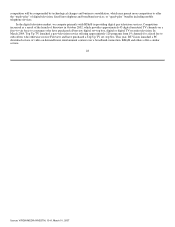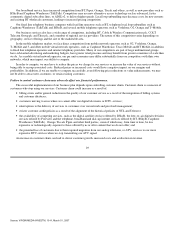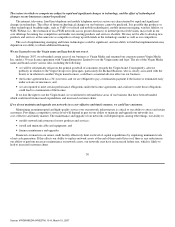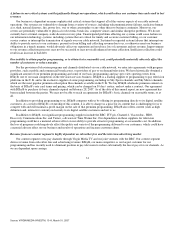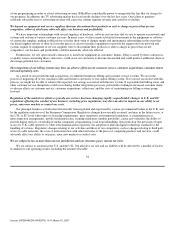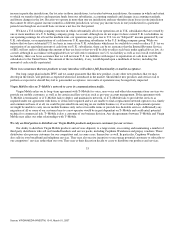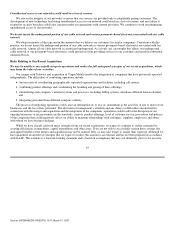Virgin Media 2006 Annual Report Download - page 30
Download and view the complete annual report
Please find page 30 of the 2006 Virgin Media annual report below. You can navigate through the pages in the report by either clicking on the pages listed below, or by using the keyword search tool below to find specific information within the annual report.
limiting or removing regulatory restrictions on use. The introduction of trading and liberalization is mainly regulated at national level.
U.K. Competition Law
The Competition Act 1998, which came into force in March 2000, introduced a prohibition on the abuse of a dominant market
position and a prohibition on anti−competitive agreements, modeled on Articles 81 and 82 of the Treaty of Rome. The Act also
introduced third party rights, stronger investigative and enforcement powers and the ability for the competition authorities to issue
interim measures. The new enforcement powers include the ability to impose fines of up to 10% of worldwide turnover. The
Competition Act is enforced by the Office of Fair Trading (OFT) and gives concurrent investigative and enforcement powers in
matters concerning communications to Ofcom.
The U.K.’s competition law framework was further strengthened by the competition provisions of the Enterprise Act 2002, which
came into force in June 2003. Under these provisions, among other things, decisions on mergers are now made by the independent
competition authorities, using competition based tests, rather than by the U.K. Government.
Under other provisions of the Enterprise Act, individuals who cause, encourage, participate in or, in some cases, even those who
have knowledge of, the making of agreements between competitors which are designed to fix prices, share markets, limit supply or
production or rig bids in the U.K., can be prosecuted and punished with unlimited fines and imprisonment for up to five years. The
courts may also order the disqualification for up to fifteen years of directors whose companies have committed a breach of U.K. or EU
competition law.
WEEE Directive
On December 12, 2006, the U.K. government adopted the Waste Electrical and Electronic Equipment Directive (the WEEE
Directive) previously adopted by the European Union relating to certain obligations associated with historical waste (as defined by the
WEEE Directive). The WEEE Directive is effective January 2, 2007 and imposes the responsibility for the disposal of waste electrical
and electronic equipment on the manufacturers of such equipment. The main provisions relate to separate collection, disposal and
recycling; standards for its treatment at authorized facilities; and collection, recycling and recovery targets. It requires distributors to
allow consumers to return their waste equipment free of charge, which would include the set−top boxes and cable modems that we
provide to our customers.
Seasonality
Some revenue streams are subject to seasonal factors. For example, telephone usage revenue by customers and businesses tends
to be slightly lower during summer holiday months. Our customer churn rates include persons who disconnect their service because of
moves, resulting in a seasonal increase in our churn rates during the summer months when higher levels of U.K. house moves occur
and students leave their accommodations between school years. In addition, our Content segment includes Virgin Media TV, which
has a seasonally higher programming spend in the fourth quarter, and sit−up’s home shopping channels, which earn potentially higher
revenues in the fourth quarter, reflecting the Christmas holiday period, which is common in the retail industry. In our Mobile segment,
fourth quarter customer acquisition and retention costs generally increase due to the important Christmas period and Mobile ARPU
generally decreases in the first quarter of each year due to the lower number of days in February and lower usage post the Christmas
period.
26
Source: VIRGIN MEDIA INVESTM, 10−K, March 01, 2007


